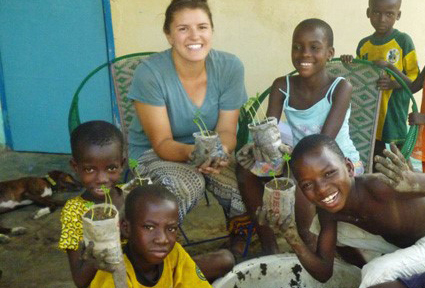Connie Gavin completed The University of Vermont’s Leadership and Management Professional Certificate Program in 2015. A skillful professional with diverse experience in education and non-profit program management, Gavin earned her undergraduate degree from UVM in 2004 and her Master of Arts at Teachers College, Columbia University.
As she began working in the non-profit world, Gavin further identified her professional goals and decided to hone her leadership and management skills. We talked to Gavin, now an Account Manager for the Invest Employee Assistance Program in Burlington, about professional development and worksite wellness.
Why did you choose UVM’s Leadership and Management Program?
I’m kind of a geek. I love learning and I have always invested in myself through education. As a young female professional, I’d been seeking formal training in leadership and management, but didn’t want a full-time program. I wanted something I could attend one day and implement the very next day at work. As a UVM Alum, I worked with a fantastic counselor at UVM’s Career Center, who helped me identify and balance my professional and personal goals.
Then I spoke with my employer about taking on leadership roles. After looking at five programs, I found that UVM’s program best matched my needs. I liked the networking opportunities and the range in topics. Plus, they use guest presenters, who are experts in their field. I also liked the price.
As an Account Manager at Invest Employee Assistance Program, you have to work with different levels of leadership and coordinate many projects. Can you talk about what your job entails?

My main role is to promote safe, healthy workplaces. I love it because I meet interesting people, I’m faced with unique challenges, and I have autonomy–perfectly balanced with a smart, creative, supportive team.
I work closely with the Vermont Education Health Initiative to promote workplace wellness and work-life balance for public school employees statewide. I partner with the Vermont League of Cities and Towns to promote and support their WorkStrong initiatives.
I collaborate with organizational leaders to integrate EAP into workplace culture and structures so that employees use the EAP proactively. I conduct presentations for employee groups to explain how their EAP can help with workplace conflict, relationship challenges, college planning, career and retirement planning, identifying resources for elderly parents, and more. The program is comprehensive and customizable; we work hard to understand each worksite’s culture and find ways to tap into their existing routines and structures.
I also participate on the Governor’s Council for Physical Fitness – Workplace Wellness Conference Planning Committee.
How has UVM’s Leadership and Management program helped you professionally?
In every seminar, I was able to apply new learning to my home life and relationships, just as I was able to apply it to work. In the Negotiation and Influence seminar, I learned to:
¨ Evaluate personal tendencies in the face of conflict and manage strengths and weaknesses to become a more effective negotiator.
¨ Discover how to win, not by defeating the other side, but by winning them over.
¨ Be better prepared to acquire support from others as you lead future negotiations.
¨ Examine ways to structure the bargaining process to accommodate joint problem- solving, brainstorming, and fact-finding.
¨ Evaluate a best alternative to a negotiated agreement, create a zone of possible agreement, and implement the mutual gains approach to negotiation.
¨ Be able to think more clearly, make smarter moves, and set the stage for more productive negotiations.
My main takeaway from this seminar was to be “heavy on problems, soft on people.”
During the Leading and Motivating Your People and the Strategic Leader seminars, one main takeaway was: Wear different leadership hats at different times— use different techniques—for different people.
During Strategic Marketing, I honed my marketing skills and determined areas for growth. I also learned to market myself and my own skills. Plus, I met my objective of taking on leadership opportunities at work.
Can you tell us about the Invest EAP?
Invest EAP is a statewide network, a public/private non-profit collaborative, and one of the few in the country. We’ve offered comprehensive EAP services since 1986. Our staff and counselors live in Vermont, so we’re in tune with local culture and events.

While most EAP work is a two-tiered individual and workplace focus, the importance of our local presence was heightened during Hurricane Irene, when Vermonters were displaced, businesses were shutting down, and people were afraid. Our counselors were able to dispatch to various locations and support those affected and the professional responders.
We serve public schools, Vermont’s municipalities, state government, private businesses, and hospitals. We offer counseling services within 20 minutes of any of our members’ home or work. Plus, our website provides videos, local and national resources, and opportunities for members to request that an EAP counselor contact them.
In our society, people work a lot, don’t take much vacation, and sit all day at their desks. What are companies doing to better promote employee health and worksite wellness?
I once heard an interview about flexible workplaces, and the individual named it spot on, “Where and when do you think of your most creative and brilliant ideas? Is it in the eighth hour of sitting at your desk or cubicle? No! It is while you’re out on a walk or in the shower at home.” This truly highlights the importance of allowing for flexibility and creativity in the workplace if you want the most out of your employees.
Below are resources I would recommend to workplaces seeking to enhance work-life balance:
- The Centers for Disease Control and Prevention (CDC) promotes a worksite wellness plan as a best practice.
- The CDC Total Worker Health™ program is a strategy integrating occupational safety and health protection with health promotion to prevent worker injury and illness and advance health and well-being.
- The Vermont Department of Health provides resources, plus a step-by-step guide for employers and worksite-wellness committees.
- Invest EAP works with the Employee Assistance Program Association’s (EAPA) Standards and Professional Guidelines.
- The Society for Human Resource Management (SHRM) offers employer resources for worksite wellness and best practices.
Was there a turning point when companies figured out that employee wellness was key for morale, health and, productivity?
EAPs have a long history, stemming from alcohol and substance abuse issues in the workplace. Then came federal legislation, which increased acceptance of EAPs. During the 1980s, EAPs became popular in the US, as legislation passed regarding labor relations and drug-free workplaces. Managers needed guidance to address personnel issues, and EAPs expanded.
By the 1990s, EAPs became a standard of employee benefits. EAP services expanded to address work-life balance, elder care, workplace violence, and supporting company-wide changes like mergers and downsizing. Also at this time, mental health entered the health and wellness arena, and EAPs provided the onramp to various clinical resources.
What are some of the biggest challenges to employees when faced with staying healthy?
Behavior change is often a big challenge for most people. Work-life balance, having a support network to make positive changes at home and at work, and having an employer that actively promotes and supports employee wellness and a flexible workplace all make a big difference.
People spend a large percentage of their lives at work. If the only access to nourishment is a vending machine full of soda and candy, and if the employer doesn’t support taking a lunch break (not to mention a brain break, opportunity to take a walk and eat something), it makes it difficult to live a healthy, well-balanced life. EAP work is short-term, but identifying resources and developing a plan helps employees move toward living healthier, more balanced lives.





